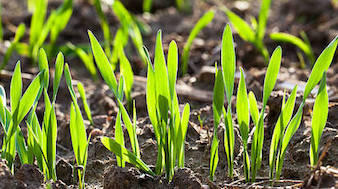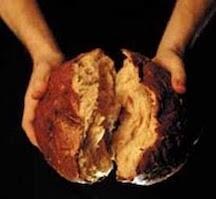 On this Fifth Sunday of Lent we find ourselves in John 12, as the public ministry of Jesus comes to a close. He will be seen no more in public after this, except during his trial and when he was hanging on the cross. So there must be a lot to see in this last public scene.
On this Fifth Sunday of Lent we find ourselves in John 12, as the public ministry of Jesus comes to a close. He will be seen no more in public after this, except during his trial and when he was hanging on the cross. So there must be a lot to see in this last public scene.
It begins rather well, as Greeks — gentiles who perhaps are converts to Judaism — finally appear on the scene, eager to see Jesus:
Now there were some Greeks among those who came up to worship at the festival. They came to Philip, who was from Bethsaida in Galilee, with a request. “Sir,” they said, “we would like to see Jesus.” Philip went to tell Andrew; Andrew and Philip in turn told Jesus. (12.20-22)
To see Jesus: a good thing to pray for, is it not? Indeed, the spiritual potency of seeing is a theme John returns to again and again. In John 9, and with a certain irony, it is only the man born blind who sees Jesus, while others are blind to the light shining right in front of them:
Jesus said, “You see him right now; in fact, he is the one speaking with you.” Then the man said, “Lord, I believe,” and he worshiped him. Jesus said, “For judgment I have come into this world, so that the blind will see and those who see will become blind.” (9.37-39)
Earlier, the Samaritan woman’s good instinct is not simply to tell her neighbors about Jesus, but to invite them to come and see him:
Then, leaving her water jar, the woman went back into the town and told her neighbors, “Come, see this man who told me everything I ever did!” (4.28-29)
And still earlier, on the first day of his ministry, seeing Jesus is basic and simple, as it was for the first disciples:
“Come,” he replied, “and you will see.” So they came and they saw where he was living, and they spent that day with him. (1.39)
Indeed, at the very start of the Gospel John portrays Jesus as the God we cannot see now quite seeable among us:
The Word became flesh and dwelt among us. We have seen his glory, the glory of the one and only Son, who came from the Father, full of grace and truth… No one has ever seen God, except the one and only Son, who is himself God and is in the bosom of the Father — he has made him known. (1.14, 18)
 To see Jesus: isn't that what the Incarnation is all about?
To see Jesus: isn't that what the Incarnation is all about?
So it is a bit of a surprise that when the Greeks come to see Jesus, and Philip and Andrew intercede on their behalf, Jesus seems merely to change the subject. Indeed, the Greeks are not mentioned again. Do they ever get to see him? Are they just forgotten? I think that the point is a different one. It seems that now, at the end of his time before the public eye, Jesus is changing what it means to see and be seen. There is glory, yes, the intense light of God in the world: but this is an all-consuming light, not something for spectators. And so Jesus shifts images, talking instead about seeds that fall to ground and become hidden there, buried and, for a time, as if dead:
The hour has come for the Son of Man to be glorified. Very truly I tell you, unless a grain of wheat falls to the ground and dies, it remains only a single seed. But if it dies, it produces many seeds. Anyone who loves their life will lose it, while anyone who hates their life in this world will keep it for eternal life… (12.23-25)
 Only when the grain germinates and breaks through the new soil and starts to rise up, do we realize it is alive. The story of the grain is the story of Jesus, and our story too: alive, hidden, dying, rising, new life… If we do not realize this — and how could we, first time around? — if we keep looking around for Jesus as someone simply to look at, we end up like people groping in a dark place:
Only when the grain germinates and breaks through the new soil and starts to rise up, do we realize it is alive. The story of the grain is the story of Jesus, and our story too: alive, hidden, dying, rising, new life… If we do not realize this — and how could we, first time around? — if we keep looking around for Jesus as someone simply to look at, we end up like people groping in a dark place:
Jesus told them, “You are going to have the light just a little while longer. Walk while you have the light, before darkness overtakes you. Whoever walks in the dark does not know where they are going. Believe in the light while you have the light, so that you may become children of light.” (12.35-36)
To not see Jesus: It is no accident then that this central part of John 12 ends with Jesus disappearing from view:
When he had finished speaking, Jesus left and hid himself from them. (12.36)
Only a few — including a few Greeks? — really understood that the time for spectatorship, merely by-standing, is over with. As Jesus prepares to die — to enter his glory — to see means to participate, not to watch from a safe distance.
 Jesus is henceforth hidden from our eyes, unless we learn to see spiritually — to look not up but down, when he is washing their feet (John 13); at the judgment seat, when Pilate cries out “See this human being!” (John 19); when Mary hears her name called and sees Jesus right next to her at the tomb (John 20); when the disciples see Jesus cooking them breakfast on the shore (John 21).
Jesus is henceforth hidden from our eyes, unless we learn to see spiritually — to look not up but down, when he is washing their feet (John 13); at the judgment seat, when Pilate cries out “See this human being!” (John 19); when Mary hears her name called and sees Jesus right next to her at the tomb (John 20); when the disciples see Jesus cooking them breakfast on the shore (John 21).
To see Jesus in the last days of Lent means to stop trying to see him out there, somewhere. Think instead about the grain of wheat that falls to the ground, that it may die, and rise, and become our daily bread. See Jesus by finding Jesus where you are, in small acts of service, in the ordinary details of life, in all the small dyings and risings that have made our pandemic year. Search your mind and heart, feel the scars on your body, see your sisters and brothers, themselves like you, like Jesus — and there he will be.
(An earlier and somewhat different version of this written homily was delivered orally in the recorded parish Mass for this weekend, which can be found here.)

